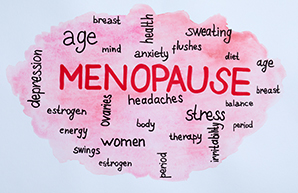“I didn’t realise what I was experiencing until I was about two years in. I thought I was just depressed!” says Elizabeth, 42.
Like many women, Elizabeth knew to expect menopause in the distant future – around the 50 year mark – but was completely blindsided by perimenopause in her late thirties.
“I was 37, just about to get married,” she says. “I became really depressed. I just didn't know what was going on. I'm not the kind of person that normally gets depressed and I just felt like the world was going to end. It was completely out of character. Nowadays, a lot more people are talking about menopause and perimenopause. But back then, nobody was; not my mother, not my friends – and I've got quite a few older friends. It was a truly awful period in my life. I felt very isolated.”
Apart from a sudden, inexplicable change in temperament, Elizabeth also began to have trouble sleeping, and was besieged by fatigue – all while her periods remained fairly regular. She only discovered what had happened when her period eventually stopped, and her gynaecologist confirmed that she was perimenopausal.
“Women are not well informed about perimenopause and menopause,” says gynaecologist and endoscopic surgeon Dr Natalia Novikova. “Perimenopausal symptoms can be very unspecific and are easily mistaken for other things.”
Erratic or missed periods are the most identifiable signs of perimenopause. However, according to Dr Novikova, some women’s periods can remain regular for much of their transition. Perimenopause can, instead, show up as mood swings, insomnia, fatigue, hot flushes, night sweats, anxiety, joint pains, migraines, weight gain, anxiety, depression, loss of libido and vaginal dryness.
Loss of bone density is another symptom, and there’s even something that’s been dubbed ‘perimenopause rage’, which some have compared to the kind of mood swings we experience during PMS – except, it can last a lot longer than a few days.
All of this is enough to plunge even the most resilient women into both a physical and psychological crisis that can wreak havoc on our work, our relationships, and our capacity to cope.
So what’s to be done?
Forewarned is forearmed: “The average age of menopause is 51,” says Dr Novikova. “But it is useful to know at what age your mother reached menopause, as it may provide a clue as to your own onset. Likewise, perimenopause.”
Unfortunately, there is no definitive test to diagnose perimenopause, and checking your hormone levels is not always conclusive. Rather, a healthcare professional will take all of your symptoms, along with your medical history, into account when making a diagnosis.
The treatment depends largely on the symptoms, adds Dr Novikova.
“I always start with lifestyle changes first, such as healthy eating, physical activity, stress management, sleep hygiene, and so on. I discuss the various options of menopausal hormonal treatment such as tablets, gels, creams, patches or intrauterine devices, and alternative remedies such as herbal medications and antidepressants.”
Hormone treatments that include oestrogen and, often, progestin remain one of the most efficient avenues for alleviating perimenopausal and menopausal symptoms, and are available in various forms such as pills, skin patches, sprays, gels, or creams.
Before you decide on a treatment, make sure you thoroughly understand the risks and benefits involved. And take heart – this too, shall pass.
IMAGE: 123rf.com

